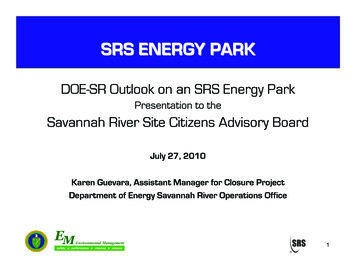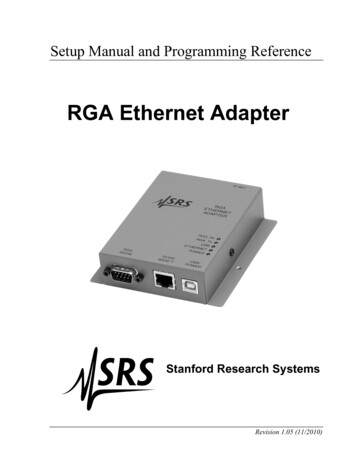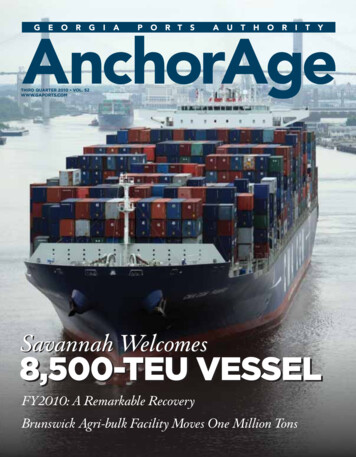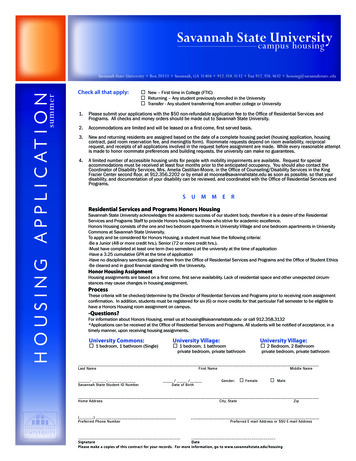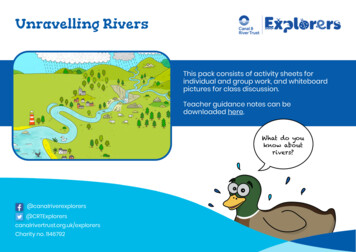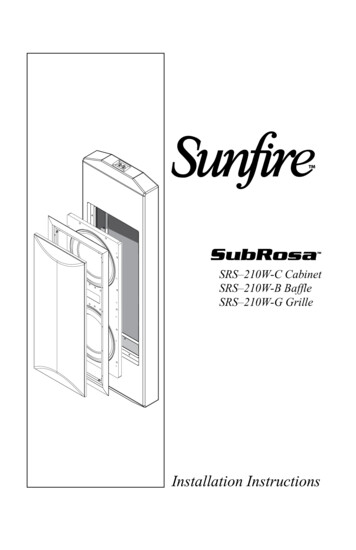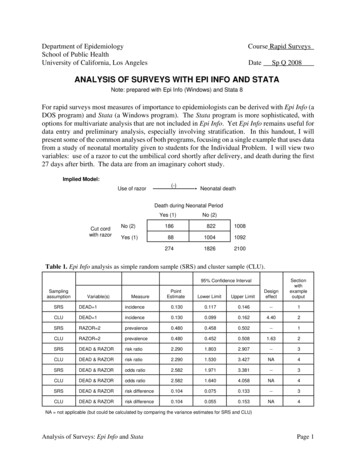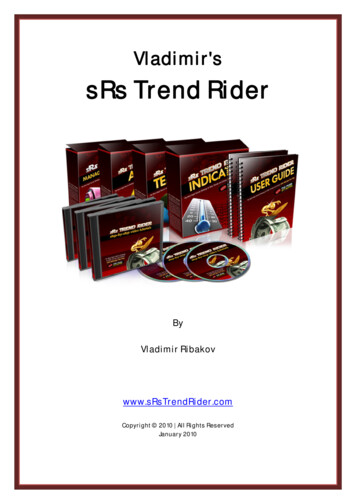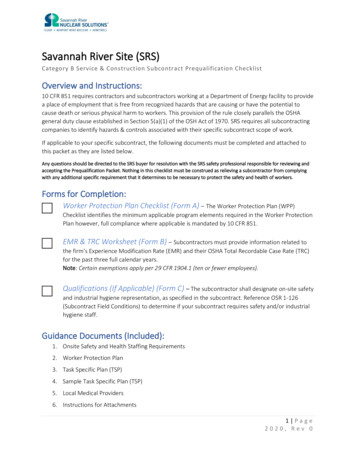
Transcription
Savannah River Site (SRS)Category B Service & Construction Subcontract Prequalification ChecklistOverview and Instructions:10 CFR 851 requires contractors and subcontractors working at a Department of Energy facility to providea place of employment that is free from recognized hazards that are causing or have the potential tocause death or serious physical harm to workers. This provision of the rule closely parallels the OSHAgeneral duty clause established in Section 5(a)(1) of the OSH Act of 1970. SRS requires all subcontractingcompanies to identify hazards & controls associated with their specific subcontract scope of work.If applicable to your specific subcontract, the following documents must be completed and attached tothis packet as they are listed below.Any questions should be directed to the SRS buyer for resolution with the SRS safety professional responsible for reviewing andaccepting the Prequalification Packet. Nothing in this checklist must be construed as relieving a subcontractor from complyingwith any additional specific requirement that it determines to be necessary to protect the safety and health of workers.Forms for Completion:Worker Protection Plan Checklist (Form A) – The Worker Protection Plan (WPP)Checklist identifies the minimum applicable program elements required in the Worker ProtectionPlan however, full compliance where applicable is mandated by 10 CFR 851.EMR & TRC Worksheet (Form B) – Subcontractors must provide information related tothe firm’s Experience Modification Rate (EMR) and their OSHA Total Recordable Case Rate (TRC)for the past three full calendar years.Note: Certain exemptions apply per 29 CFR 1904.1 (ten or fewer employees).Qualifications (If Applicable) (Form C) – The subcontractor shall designate on-site safetyand industrial hygiene representation, as specified in the subcontract. Reference OSR 1-126(Subcontract Field Conditions) to determine if your subcontract requires safety and/or industrialhygiene staff.Guidance Documents (Included):1. Onsite Safety and Health Staffing Requirements2. Worker Protection Plan3. Task Specific Plan (TSP)4. Sample Task Specific Plan (TSP)5. Local Medical Providers6. Instructions for Attachments1 Page2020, Rev 0
Attachments:Resume (If Applicable) – On-site safety and industrial hygiene representation requiresminimum staffing qualifications. To satisfy this requirement, submit a resume for each proposedindividual for review and acceptance.Worker Protection Plan / Site Specific Safety and Health Plan – A WPP specifieshow a company will implement, maintain, and manage subcontract regulatory compliance whileconducting business under contract at SRS. In accordance with 10 CFR 851, the WPP mustmandate an environment that is free from recognized hazards and requires participation by alllevels of management and employees in the prevention and recognition of unsafe acts andconditions.Task Specific Plan (TSP)/Job Hazard Analysis (JHA) (If Applicable) – 10 CFR 851,“Appendix A”, requires subcontractors to perform a job hazard analysis for all tasks associatedwith their work scope. To satisfy this requirement, subcontractors shall submit Task Specific Plans(TSPs), commonly referred to as Job Hazard Analyses (JHA), for initial review and acceptance.Additionally, the subcontractor will provide TSPs to the SRS Subcontract Technical Representativefor review and acceptance prior to starting any onsite work at SRS.Note: Certain contracts are not required to provide a TSP prior to starting onsite work at SRS.Insurance Confirmation of EMR Rate – Subcontractors must provide a letter from itsWorkman’s Compensation Insurance Carrier certifying the EMR data provided to SRS.OSHA 300 Logs/Summaries (If Applicable) – Subcontractors must attach copies of theOSHA Annual Summary Logs (OSHA’s Form 300A) for the previous 3 years.Note: Certain exemptions apply per 29 CFR 1904.1 (ten or fewer employees).Focused Observation (FO) Checklist – SRS has specific Focused Observation (safety)Checklists that subcontractors must incorporate into their SRS Specific WPPs. Checklist applicableto the subcontracted work are found on OSR 1-183. Access each applicable checklist located onthe SRNS Internet Homepage at:https://www.srs.gov/general/busiops/PMMD/SRNS general provisions.htm#gen provisions–Focused. Identify the applicable lines of inquiry (LOIs) and complete and sign the bottom portionof each checklist and attach to this packet.2 Page2020, Rev 0
WPP Checklist (FORM A)InstructionsComplete Section I and II. For each element in Section II, identify the requirement in your corporateprocedures AND identify the location (ie: page number) in your company documentation. If youincorporate sections of your company’s safety program, be sure it addresses each program element inthis checklist. Subcontractors must identify all hazards involved with their work scope.This checklist identifies the minimum safety and health program elements that SRS expectssubcontractors to address in their SRS Site Specific WPP. It is not intended to be all inclusive and shouldbe used only as guidance to support minimum documentation. SRS Site Specific WPPs must comply withall local, state and federal requirements, including 10 CFR 851, all subsequent updates and technicalamendments.Section I:Subcontractor Name:RFP/Proposal:SRS Buyer:Subcontract Technical Representative (STR):*Assigned Competent Person (ACP):Licensed Medical Provider:Note: Select from provided list or type name of otherSafety Representative/Professional (If Applicable):Note: Select which option applies to your contractIndustrial Hygiene Professional/Technician (If Applicable):Note: Select which option applies to your contractPrequalification Checklist Revision Number:Note: If this is your first revision, select “R0”Select or type name of otherSelect from listSelect from listR0 (Initial)*Assigned Competent Person: Individual who determines need for visitor/vendor, determines initial hazard designation,identifies proper checklists and determines if a focused observation is necessary, prints and reviews detailed checklists at job site,provides job site safety briefings and performs focused observations. This individual may be a SRS Performing Entity Employee ortheir subcontractors.Signature: Date:3 Page2020, Rev 0
Section II (Required):Site Specific RequirementsFitness for Duty: Established policies are in place to ensure employees report to work and perform theirassigned task(s) safely and free from impairments.YesNoPage:Reference: 10 CFR 851 Appendix A, Section 8Accidents/Incidents/Investigations: All employees are required to immediately report accidents, injuriesor incidents to the STR and participate in the investigation. Recordkeeping is maintained in alignmentwith OSHA 1904. DOE form 5484.3 will be completed and submitted to the STR within two days followingany injury/illness. In the event of an investigation leading to corrective action to prevent reoccurrence,documentation and action will be prepared and submitted to the STR for review and acceptance.YesNoPage:Reference: 10 CFR 851.20 & 26, 29 CFR 1904Safety Policy: The subcontractor has an established written policy including clear goals and objectivesalong with outlined personnel responsibilities, authority, and accountability.YesNoPage:Reference: 10 CFR 851.20Applicability of WPP to Employees: Employees will be provided a copy of the WPP as well as trained andbriefed on the requirements specified within.YesNoReference: 10 CFR 851.11 & 25Time Out: Employees have the right and authority necessary to call a time out when unsafe conditionsare observed and/or employee actions are likely to cause injury to them, other personnel, or causedamage to property or the environment.YesNoPage:Reference: 10 CFR 851.20New hire employee safety orientation:YesNoPage:Reference: 10 CFR 851.25Employee Safety Meetings:YesNoPage:Reference: 10 CFR 851.20 & Appendix A4 Page2020, Rev 0
Employee’s rights relative to company documentation: Employees have been informed that they havethe right to request and receive the results of safety and health inspections and accident investigationreports.YesNoPage:Reference: 10 CFR 851.20Concealing or destroying information: Employees have been informed that they are not to conceal nordestroy any information concerning non-compliance or potential non-compliance with 10 CFR 851 workersafety and health program, OSHA or any other regulatory compliance requirements.YesNoPage:Reference: 10 CFR 851.26Company Training Program: Company training is designed to instruct each employee on general safetyprocedures and requirements specific to the employee’s job assignment. Documentation of training ismaintained.YesNoPage:Reference: 10 CFR 851.25General Personal Protective Equipment:YesNoPage:Reference: 10 CFR 851.22, 1910 Subpart I, 1926 Subpart EEquipment, Products, and Services: Hazards have been addressed when selecting or purchasingequipment, products, and services.YesNoPage:Reference: 10 CFR 851.225 Page2020, Rev 0
Occupational Medicine & First AidReturn to work policy following on the job injury:YesNoPage:Reference: 10 CFR 851 Appendix AEmployee(s) trained in first aid:YesNoPage:Reference: 29 CFR 1910 Subpart KFirst Aid Supplies: First aid kits and other related supplies will be provided during work at SRS. Kits andsupplies will be maintained per the supplier’s and offsite medical provider’s guidance/recommendations.YesNoPage:Reference: 29 CFR 1910 Subpart KMaintenance and employee access to medical records: A record, containing any medical, health history,exposure history, and demographic data collected for the occupational medicine purposes, must bedeveloped and maintained for each employee for whom medical services are provided. Access to theserecords must be provided to employees if requested.YesNoPage:Reference: 10 CFR 851 Appendix A6 Page2020, Rev 0
Section III:Use the following section to identify which components in Section IV are within the subcontract scope ofwork. Components identified as applicable must be reflected in Section IV as well as in the WPP.Complete Section III and Section IV respectively in full to prevent possible delays in the approval process.Included in Scope of WorkEmployees will be performing servicing ormaintenance on machines or equipment where theunexpected startup, energization, or the release ofstored energy could occur and cause personal injury.The machine or equipment will be de-energized andcontrolled by the OSHA Cord and Plug Exemption.Employees will be performing servicing ormaintenance on machines or equipment where theunexpected startup, energization, or the release ofstored energy could occur and cause personal injury.The machines or equipment can’t be de-energized andcontrolled via OSHA Cord and Plug Exemption.Check if applicableTable in Section IV4Subcontractors willcomply withProcedure 8Q32,Lockout/Tagout (L/T)Employees will be performing servicing ormaintenance on machines or equipment where theequipment is required to be energized (i.e.troubleshooting, voltage reading, etc.).Subcontractors willbe SRNS QualifiedElectrical Worker(QEW) or NFPA 70Etrained andelectrically qualifiedEmployees or equipment employee is handling orusing has the potential of coming within 20’ ofoverhead electrical lines. Worker(s) is not a SRNS QEWor NFPA 70E trained and electrically qualified.Subcontractors willcomply withProcedure 8Q10Employees will be performing welding and/or hotwork tasks, such as brazing or grinding.371929Employees will be exposed to a respiratory hazardand/or required to wear a respirator.37Employees will be performing work in an environmentcontaining Asbestos.372529Employees will be performing work in an environmentcontaining Lead.372629Employees will be performing work in an environmentcontaining Silica.7277 Page2020, Rev 0
Included in Scope of WorkCheck if applicableTable in Section IVEmployees will be performing work in an environmentcontaining Polychlorinated Biphenyls.Subcontractorsexposed toPolychlorinatedBiphenyls will benotified prior toperforming work andappropriate controlswill be established.Employees will be using Beryllium articles and/ormaterials (containing 0.1% or greater) during workperformed at SRS.Beryllium articles andmaterials areprohibited on sitewithout appropriateapproval. Specificprovisions will applyfor approved use.Employees will be performing work in an area wherenoise exceeds the ACGIH 8-hour TWA of 85 dB.Employees may experience potential health hazardsfrom work in hot environments (may be inside and/oroutside).Employees may experience potential health hazardsfrom work in cold environments (may be inside and/oroutside).Employees will be entering or performing work in aconfined space (permit or non permit).Employees will be exposed to ergonomic hazardswhile performing work.Employee assignment requires the use of hand andportable powered tools and/or other hand-heldequipment.Employees will manually handle or use mechanicalequipment to move and store materials.Employees will be exposed to hazards that can resultin slips, trips, falls and other injuries.Employees will be performing elevated work at aheight greater than 4 feet (service subcontracts) or 6feet (Davis-Bacon subcontracts).Employees will be using or performing work on ascaffold and/or scissor lift.Employees will be using powered platforms, vehiclemounted work platforms and/or manlifts to performwork.781217245691210118 Page2020, Rev 0
Included in Scope of WorkEmployees will be using hoisting equipment (cranes,derricks, hoists, elevators, conveyors) to performwork.Check if applicableTable in Section IV13Employees will be using forklifts and/or other vehiclesthat carry, push, pull, lift, stack, or tier material.1420Employees will be performing demolition work.21Employees will be required to drive or ride in a motorvehicle.20The nature of the work performed includes hazardsthat require a comprehensive fire safety andemergency response program along with anacceptable fire protection program.Employees will handle, store and/or use flammableliquids, combustible liquids or compressed gases.Employees are involved in activities driving thesubcontractor to be in compliance with OSHA’sHazardous Waste Operations and EmergencyResponse (HAZWOPER) standard.Employees will be required to work in an environmentrequiring an established Laser Safety Program.Employees will be performing drilling and penetrationactivities.Operations and activities performed will be associatedwith the use of non-ionizing radiation (NIR) emitters.Employees are exposed to hazardous chemicals.181516222328299 Page2020, Rev 0
Section IV (Where Applicable):Table 1Heat Stress (ACGIH)YesNoPage #YesNoPage #Use screening criteria using the effective Wet-Bulb Globe Temperature(WBGT) to determine exposure to heat stressDescription of how the criteria are applied to prevent over exposure toheat stressPre-hydration and regular fluid replacementTraining on signs & symptoms related to heat illnessWorker acclimatization to work environment conditionsHeat strain monitoringReporting mechanisms for heat-related disordersSelf-determination of exposureEvaluation of the potential for preexisting conditions which maypredispose workers to heat illnessTable 2Cold Stress (ACGIH)Method to evaluate wind chill and dry bulb air temperature todetermine exposure to cold stressControls to prevent over exposure to cold stressTraining on signs and symptoms related to cold illness and injuryProvide warming locationsEvaluation of the potential for preexisting conditionsPersonal protective equipment to be used by employeesReporting mechanisms for cold-related disorders10 P a g e2020, Rev 0
Table 3Respiratory Protection Program (1910.134, ANSI Z88.2)YesNoPage #Cord & Plug (1910.147)YesNoPage #Hand and Portable Powered Tools and Other Hand-Held EquipmentYesNoPage #Designated Respiratory Protection Program AdministratorPermissible practice established through use of the hierarchy ofcontrolsMedical evaluation including OSHA 1910.134 QuestionnaireAnnual respiratory trainingRespirator fit testingAppropriate selection of NIOSH approved respirators including hazardidentification and evaluationAir purifying respirators used for protection against gases and vaporsare equipped with end of service life indicator or change out scheduleis implemented (if applicable)Safe practices for respirator useRespirators issued are appropriately cleaned and disinfectedBreathing air quality and useWorkplace evaluations are conducted as necessary to ensure writtenrespiratory protection program is effectively implementedTable 4Exposure to the hazards of unexpected energization or startup of theequipment is controlled by the unplugging of the equipment from theenergy sourceThe plug is under the exclusive control of the employee performing theservicing or maintenanceTable 5(1910 Subpart P, 1926 Subpart I)Employee trainingInspectionProper storage, care, and useHousekeepingProper shielding, guarding, or attachments (if applicable)Personal protective equipment to be used by employees11 P a g e2020, Rev 0
Table 6Materials Handling and Storage (1910.176, 1926 Subpart H)YesNoPage #Proper storage and handling of materialsHousekeepingEquipment use – hand trucks, dollies, carts (if applicable)Equipment use – conveyors, cranes (if applicable)Complete table 13Equipment use – powered industrial trucks (if applicable)Complete table 14Personal lifting techniques (if applicable)Complete table 24Table 7Exposure Assessment for Chemical, Physical and Biological Hazards(851.21 & 23, ACGIH)YesNoPage #YesNoPage #Applicable baseline exposure assessments are performed anddocumented prior to or during scheduled work. Assessments must beconducted as often thereafter as necessary to ensure compliance with10 CFR 851.Exposure assessment program including methods to assess hazardsand detail documentationStatement in WPP that commits subcontractor to follow whichever isstricter: ACGIH TLVs or OSHA PELsTable 8Hearing Conservation Program (1910.95, 1926.52, ACGIH)Exposure monitoring (for example, a baseline survey of noiseproducing equipment)Implementation of noise controlsEmployee training for those exposed to TWAs of 85 dB and above atleast annually in the effects of noise; the purpose, advantages, anddisadvantages of various types of hearing protectors; the selection, fit,and care of protectors; and the purpose and procedures ofaudiometric testingUse of hearing protection devices to all workers exposed to 8-hourTWA noise levels of 85 dB or aboveAppropriate recordkeeping of noise exposure measurement recordsand audiometric test resultsEstablish and maintain a Hearing Conservation Program to includebaseline audiograms, annual audiograms and training for thoseexposed to 8-hour TWA noise levels of 85 dB or aboveProgram must confirm compliance with American Conference ofGovernmental Industrial Hygienists (ACGIH) noise exposure limits (85dBA TLV versus OSHA 90 dBA PELs)Use of ACGIH table for TLVs for noise exposure stay times12 P a g e2020, Rev 0
Table 9Walking and Working Surfaces (1910 Subpart D, 1926 Subpart X)YesNoPage #YesNoPage #YesNoPage #Housekeeping expectations and practicesLadder inspection protocolLadder storage and useProper selection of ladders for given tasksGuarding for open sided floors/platforms/runwaysTable 10Scaffolding (1910 Subpart D, 1926 Subpart L)Employee trainingCompetent and qualified person responsibilitiesFall protection requirements during erection and dismantlingScaffold inspection and useTable 11Powered Platforms, Aerial Lifts and Vehicle – Mounted Work Platforms(851 Appendix A, 1910 Subpart F, 1926)Operator training to the specific modelUse of personal fall arrest system to include body harness, lanyard,lifelineInspection of all components of the personal fall arrest systemOperation of aerial lift including maximum intended load and loadcapacityPre-use inspection of aerial lift to verify equipment and all componentsare in safe operating condition according to the manufacturer’srecommendationsAvailability of operator’s manual13 P a g e2020, Rev 0
Table 12Fall Protection (1926 Subpart M, 1910 Subpart D & I)YesNoPage #YesNoPage #Employee training and informationAppropriate protection is provided when employees are working atheights of six feet or more (construction) or four feet or more (service)Guardrail systems – height of railings, load ratings (if applicable)Safety net systems – use of safety net system, installation, inspection,testing (if applicable)Personal fall arrest or restraint systems – harness, lanyard, anchorage,inspections (if applicable)Positioning device system – anchorage, components, inspections (ifapplicable)Fall protection plan (if applicable)Guarding for exposed holes (if applicable)Personal protective equipment to be used by employeesTable 13Cranes, Derricks, Hoists, Elevators and Conveyors(1926 Subparts N & CC, 1910 Subpart N)Acknowledge SRS work will be in compliance with OSHA’s Crane andDerricks in Construction Rule and review of OSHA’s Small EntityCompliance Guide for Final Rule @ lOperator training/qualification (operator must provide NCCCOcertification)Rigging personnel training/qualification (must provide NCCCO or thirdparty certification)Signal personnel training/qualification or certificationSafe operationsLoad capacitiesHand signalsInspections/maintenance/servicesRigging – requirements, inspection and components14 P a g e2020, Rev 0
Table 14Powered Industrial Lift Trucks (851 Appendix A, 1910.178, 1926.602)YesNoPage #YesNoPage #YesNoPage #Training and certifications (as applicable for operators and spotters)Class designations/labels/safety devices/inspections including anyattachmentsPre-use inspections and/or checklistsUnderstanding of situational hazards and responsibilitiesMethods for fueling/charging machineryMaintenance program including any attachmentsUse of signs and traffic control devicesTable 15Flammable and Combustible Liquids and Compressed Gases(1910.106, 1910.101, 1926.152)Employee training to include storage, handling, transfer, inspection,and use requirements for flammable liquids and compressed gasesAvailability of portable fire extinguishers that satisfy rating, location,quantity, and inspection requirementsClosed containers, storage tanks, and/or fire cabinets meet design,ventilation, construction labeling and capacity requirementsUse of controls in locations where flammable vapors may be presentto eliminate or prevent sources of ignition including, but not limited toopen flames, smoking, welding, sparks, radiant heat, lightning, andchemical reactionsRefueling practices that meet shut off and cool down requirements forgasoline engines/motorsPersonal protective equipment to be used by employeesTable 16Hazardous Waste Operations (1910.120, 1926.65)Employee training (40 Hour or 24 Hour)Supervisor TrainingCurrent organizational structure to establish the specific chain ofcommand and specify the overall responsibilities of supervisors andemployeesEmergency Response Plan for safe and effective responses, includingthe necessary PPE and other equipmentPersonal Protective Equipment to be used by employeesDecontamination Procedures (if applicable)Monitoring methodology to be used (if applicable)Handling of Drums and Containers (if applicable)Tank and Vault Procedures (if applicable)Medical surveillance (if applicable)15 P a g e2020, Rev 0
Table 17Confined Space Program Elements (1910.146, 1926 Subpart AA)YesPermit Required Confined SpacesNoPage #Training for entry to include the roles and responsibilities of the EntrySupervisor, Attendant, and Entrant; hazards; hazard controls;atmospheric monitoring; rescue planning, and confined space recordsHazard evaluation methods including identification of the commonphysical and atmospheric hazards, work activities which wouldgenerate physical and/or atmospheric hazards, an oxygen-deficient orenriched atmosphere in Confined SpacesPermit Required Permits and approval(s). Must include (4) majorelements: Entry Permit; Confined Space Rescue Plan; Entrant,Attendant, & Entry Supervisor Log; and Air Monitoring Log.Responsibilities of entry supervisorResponsibilities of authorized entrantResponsibilities of authorized attendantsMethods to perform Atmospheric Testing and monitoring to evaluatethe hazards within the space and for verification of Acceptable EntryConditionsMeans for rescue and retrieval. Please note that only the SRS FireDepartment may perform entry rescue.Non-Permit Required Confined SpacesHazard evaluation methods including identification of the commonphysical and atmospheric hazards, work activities which couldgenerate physical and/or atmospheric hazards, an oxygen-deficient orenriched atmosphere in Confined SpacesNon-Permit Required Confined Space ProgramNon-Permit Required Permits and approval(s). Must include majorelements: work location, controls that are in place, and approvals.Methods to perform Atmospheric Testing and monitoring to evaluatethe hazards within the space and for verification of Acceptable EntryConditionsMeans for rescue and retrieval. Please note that only the SRS FireDepartment may perform entry rescue.16 P a g e2020, Rev 0
Table 18Fire Protection (851.24, 851 Appendix A, 1910 Subpart L)YesNoPage #Approved, portable fire extinguishers are readily accessible andunobstructedPortable fire extinguisher selection and distribution is based on theclasses of anticipated workplace fires and on the size and degree ofhazard which would affect their usePortable fire extinguishers are inspected, maintained and tested at therequired frequencyPortable fire extinguishers are stored in the appropriate location andwithin the appropriate travel distance based on class of anticipatedworkplace fires and employees are familiar with the locationAlternate equivalent protection is provided when portable fireextinguishers are removed from service for maintenance andrechargingTraining and educational programs are provided to employees at therequired frequency17 P a g e2020, Rev 0
Table 19Hot Work-Grinding, Welding, Cutting and Brazing(1910 Subpart Q, 1926 Subpart J)Note: At SRS, a How Work Permit (HWP) will be required. The HWP will be provided by SRS duringthe development of the work package.Exposure assessmentYesNoPage #Complete table 7Employee training & qualificationPersonal protective equipment to be used by employeesRespiratory protectionComplete table 3Hazard communicationComplete table 29Fire protection and prevention-Fire extinguishing equipment-Relocation of fire hazards-Designated safe location-Guards and coverings-Fire watch-Walls, floors, and ceilings-Enclosed spaces-Drums, pails, hollow structures, and other contains/containedflammable liquids, toxic or flammable substancesVentilation and protectionUse of welding or flash screenConfined spaces (if applicable)-Ventilation-Monitoring-Arc welding electrodes and torch valves-Toxic materialsGas welding and cutting (if applicable)-Compressed gas cylinder management-Fuel gas and oxygen manifolds and hoses-Torches-Regulators and gauges-Oil and grease hazardsArc welding and cutting (if applicable)-Manual electrode holders-Welding cables and connectors-Ground returns and machine grounding-Shielding from arc flashHot work in way of preservative coatings (if applicable)-Stripping-Air line respiratorsResistance welding (if applicable)18 P a g e2020, Rev 0
Table 20Motor Vehicle Safety (851.24, 851 Appendix A, 1926 Subpart O)Note: Tractors, platform lifts and other similar specialized equipment powered by electric motor orinternal combustion engineYesNoPage #YesNoPage #Operator training & qualificationsVehicle maintenance/before use inspection, and safe operationprogramThe availability of manufacturer’s operator manualUse of safety devices i.e. seat belts, mirrors, flagman, signalsTable 21Demolition (1926 Subpart T)Preparatory operations – demolition methods, necessary equipment,and measures to perform the work safelyPreparatory operations – service lines shut offPreparatory operations – determination of hazardous chemicals, gases,explosives, and flammable materials to include testing and purgingPreparatory operations – engineering survey by a competent personAppropriate guards/covers for wall and floor openingsWalkways/ladders (if applicable)Complete table 9Removal of materialsSafe work practices for mechanical demolition (if applicable)Complete table 13Personal protective equipment to be used by employeesMethods to control Silica exposure (if applicable)Table 22Laser Use and Safety (ANSI Z136.1)Note: Requirements listed applicable for class 3B and 4 lasers.Complete table 27YesNoPage #Employee trainingProper use, service and storageIdentified laser safety officerImplementing engineering, administrative and procedural controlsPersonal protective equipment to be used by employeesUse of protective barriers/warnings, signs and labelsMedical surveillance (if applicable)19 P a g e2020, Rev 0
Table 23Drilling and PenetrationYesNoPage #YesNoPage #Depth control on tools that penetrate walls and floorsPersonal protective equipment to be used by employeesAppropriate methods to monitor for drilling/cutting of materialsNon-intrusive survey equipment to determine (if) contents behindsurface penetrationUse of visual inspection tools to determine the area behinddetermined penetrationCompletion of penetration briefing TMAR7000Table 24Ergonomics (851 Appendix A, ACGIH)Worksite Analysis Program including methods to recognize theproblem, evaluate suspected jobs for possible risk factors and identify& evaluate causative factorsUse of controls to eliminate or reduce risk factors associated withwork-related musculoskeletal disorders (MSDs)Medical Management Program to encourage early reporting ofsymptoms by workers, provide ongoing surveillance and evaluatio
Additionally, the subcontractor will provide TSPs to the SRS Subcontract Technical Representative for review and acceptance prior to starting any onsite work at SRS. Note: Certain contracts are not required to provide a TSP prior to starting onsite work at SRS. Insurance Confirmation of EMR Rate - Subcontractors must provide a letter from its
